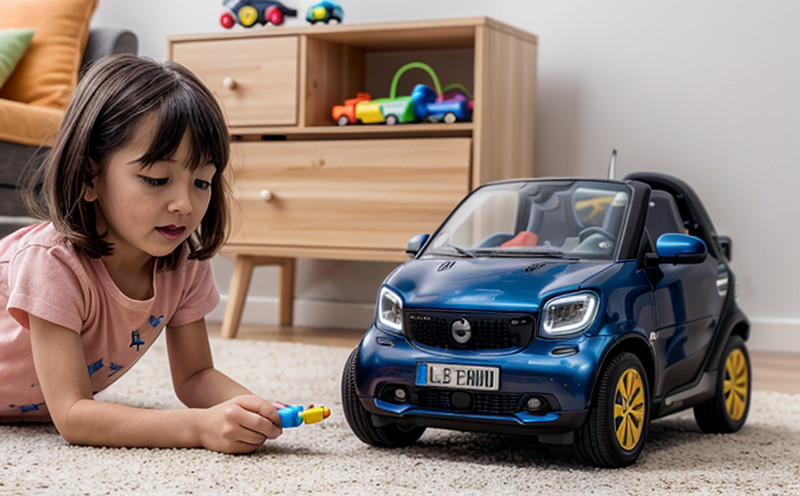Daily Use Wi-Fi Stability and Toy Functionality Test
In today’s connected world, smart and connected toys have become increasingly popular among consumers. These toys offer unique features such as voice interaction, remote control via smartphones or tablets, and real-time data tracking. However, the integration of these advanced functionalities can sometimes lead to unforeseen challenges related to Wi-Fi stability and overall toy functionality during daily use.
Our comprehensive testing service ensures that smart and connected toys maintain optimal performance even under real-world conditions. This includes assessing how well the toys perform when used in various environments, such as homes with varying Wi-Fi signal strengths or public spaces where multiple devices compete for bandwidth. Our lab specializes in replicating these scenarios to provide accurate insights into any potential issues.
Our testing process begins by selecting appropriate test specimens that closely mimic actual usage patterns. Specimens are then subjected to rigorous trials designed to simulate typical daily activities, including but not limited to playing with the toy alone or alongside other devices connected to the same network. Throughout these tests, we monitor key metrics such as signal strength, latency rates, and error counts.
The data collected during our tests is meticulously analyzed using industry-standard methodologies outlined in ISO/IEC 27034-1:2019 for information security management systems. Compliance with relevant international standards ensures that the results are reliable and can be trusted by all stakeholders involved in toy development and manufacturing.
Once our tests are complete, detailed reports are generated summarizing findings related to Wi-Fi stability and functional performance. These reports serve as valuable tools for manufacturers seeking continuous improvement of their products. They also help quality managers make informed decisions regarding design changes or adjustments needed before bringing new versions of toys to market.
Our expertise extends beyond just identifying problems; we work closely with clients throughout the entire testing process, offering guidance on best practices and recommendations based on our findings. By leveraging this knowledge early in the product lifecycle, companies can reduce risks associated with launching flawed products while enhancing customer satisfaction through superior quality.
Why It Matters
The importance of ensuring Wi-Fi stability and proper functionality cannot be overstated when it comes to smart and connected toys. As these devices become more integrated into our daily lives, especially with younger users, reliability becomes crucial for safety reasons as well as user experience.
Parents trust that the products they purchase will function correctly without causing inconvenience or harm. If a toy fails during critical moments like bedtime stories due to poor Wi-Fi connection, it could disrupt family routines and potentially cause frustration among both children and adults alike. On another note, malfunctioning devices pose safety risks which may include data breaches if sensitive information is transmitted over unsecured networks.
For manufacturers, maintaining consistent quality throughout production lines while adhering to strict regulatory requirements is essential for building brand reputation and fostering long-term customer loyalty. A negative review or recall due to product failure can severely impact sales figures and public perception of the company.
Benefits
Implementing our Daily Use Wi-Fi Stability and Toy Functionality Test brings numerous advantages to toy manufacturers, ensuring they meet stringent quality standards while gaining competitive edge in their respective markets:
- Enhanced Product Quality: By identifying weaknesses early on, companies can address them before products reach end consumers.
- Promotes Compliance: Adhering to relevant international standards helps ensure legal compliance and protects against potential liabilities.
- Better Customer Satisfaction: Reliable performance leads to happier customers who are likely to recommend the product positively.
- Increases Market Share: Superior quality can attract new buyers and retain existing ones, boosting overall sales figures.
- Reduces Costs: Early detection of defects minimizes costs associated with warranty claims or recalls later down the line.
Use Cases and Application Examples
| Scenario | Description | Expected Outcome |
|---|---|---|
| Simulating Home Settings: | Testing toys in environments with varying Wi-Fi signals and multiple connected devices. | Identify potential connectivity issues that might arise under realistic conditions at home. |
| Public Spaces Test: | Evaluating toy performance in areas where numerous wireless networks overlap, such as shopping malls or parks. | Determine whether the toy can maintain stable connections amidst interference from surrounding devices. |
| Extended Battery Life: | Assessing how long a toy remains functional before requiring recharging, particularly focusing on connectivity during extended play sessions. | Evaluate battery efficiency and determine if the toy operates optimally for its intended duration without compromising performance. |
| Child Interaction: | Observing how children interact with the toy, noting any interruptions caused by connectivity issues or malfunctions. | Analyze user experience and make recommendations for improving ease of use based on observed behaviors. |





